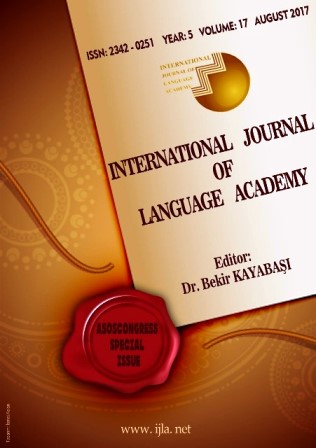Author :
Abstract
Köy ya da kasaba yaşamı, 1950’li yıllardan sonra Türk romanında muhteva olarak daha çok yer edinmeye başlar. Ömer Polat da 1970’li yıllardan sonra yayımladığı romanlarında taşrayı, köyü, kasabayı ele alır. Yazar, kendine özgü kuralların hüküm sürdüğü taşra düzeninde kadınların konumunu anlatmayı ihmal etmez. Bir “kişi”den ziyade bir “dişi” olarak algılanan kadın, Polat’ın ilk romanlarından itibaren işlenegelir. Romancı, kendi yaşam serüveninden de istifade ederek taşradaki kadını anlatır. Bu açıdan kurgusal dünya ile gerçek dünya arasında bir paralellik söz konusudur. Yani romandaki kadınlar, ilgili dönemlerde gözlemlenebilen kadınlardır. Bu durumun bugün bile, sınırlı da olsa, geçerli olduğu söylenebilir.Bu çalışmada Ömer Polat’ın yayımlanan beş romanı incelenmiş ve kadının konumuyla ilişkilendirilebilecek hususlar tespit edilmiştir. Bir taraftan kadının toplumsal statüsü değerlendirilmiş diğer taraftan birey olarak kadın anlatılmaya çalışılmıştır. Yazarın özellikle ilk üç romanı, kadına dair zengin izlekler taşır.
Keywords
Abstract
The village or town life begins to gain more space as a content in the Turkish novel after 1950s. Ömer Polat also touches on the country, villages and towns in his novels published after 1970s. The author does not neglect to describe the position of women in the provincial order ruled by its own rules. The woman, perceived as a “female” rather than a “person” is processed from Polat’s first novels. The novelist narrates the woman in the country, taking advantage of his own life adventure. In this respect, there is a parallelism between the fictional world and the real world. In other words, the women in the novel are those who can be observed in the related periods. It is said that this still holds true even today, limited though.In this paper, five published novels of Ömer Polat have been examined and the aspects that could be associated with the position of woman have been established. On the one hand, the social status of the woman has been evaluated and on the other hand the woman has been narrated as an individual. Particularly, the first three novels of the author carries rich themes about women.





